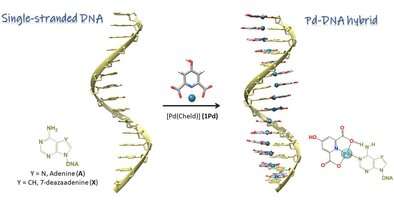Nanowires are vital components for future nanoelectronics, sensors, and nanomedicine. To achieve the required complexity, it is necessary to control the position and growth of the metal chains on an atomic level. In the journal Angewandte Chemie, a research team has introduced a novel approach that generates precisely controlled, helical, palladium–DNA systems that mimic the organization of natural base pairs in a double-stranded DNA molecule.
A team from Europe and the U.S. led by Miguel A. Galindo has now developed an elegant method for producing individual, continuous chains of palladium ions. The process is based on self-organized assembly of a special palladium complex and single-stranded DNA molecules.
In recent years, DNA has become an important tool for nanoscience and nanotechnology, particularly because of the possibility of “programming” the resulting structures through the base sequence of the DNA used. The incorporation of metals in DNA structures can give them properties such as conductivity, catalytic activity, magnetism, and photoactivity.
However, organizing metal ions in DNA molecules is not trivial because metal ions can bind to many different sites. Galindo’s team developed a smart method for controlling the binding of palladium ions to specific sites. They use a specially constructed palladium complex that can form base pairs with natural adenine bases in a strand of DNA. The ligand in this complex is a flat, aromatic ring system that grasps three of the four binding positions available on the palladium ion. The fourth position of the palladium is then available to bind to a very specific nitrogen atom in adenine. The ligand also possesses oxygen atoms capable of forming a hydrogen bond with the neighboring NH2 group of the adenine. This binding pattern corresponds exactly to a Watson–Crick base pairing, but now mediated by a palladium ion, which makes it considerably stronger than natural Watson–Crick pairing.
If a DNA strand made exclusively of adenine bases is used, one palladium complex binds to each adenine. The flat ligands assemble themselves into coplanar stacks, just like natural bases. This results in a double strand made of DNA and palladium complexes that corresponds to a natural DNA double helix in which one strand has been replaced by a supramolecular stack of continuous palladium complexes.
Although the team has yet to demonstrate the conductive properties of these systems, it can be anticipated that the correct reduction of these metal ions could lead to the formation of a conductive nanowire with a highly controlled structure. The research group is currently working in this line as well as in the modification of the ligand, which can also provide new properties to the system.
Researchers introduce metallic ions within a DNA molecule, which will have many uses in biotechnology and biomedicine
More information:
Antonio Pérez‐Romero et al. Single‐Stranded DNA as Supramolecular Template for One‐Dimensional Palladium(II) Arrays, Angewandte Chemie International Edition (2021). DOI: 10.1002/anie.202015554
Citation:
Single-stranded DNA as supramolecular template for highly organized palladium nanowires (2021, March 26)
retrieved 28 March 2021
from https://phys.org/news/2021-03-single-stranded-dna-supramolecular-template-highly.html
This document is subject to copyright. Apart from any fair dealing for the purpose of private study or research, no
part may be reproduced without the written permission. The content is provided for information purposes only.



